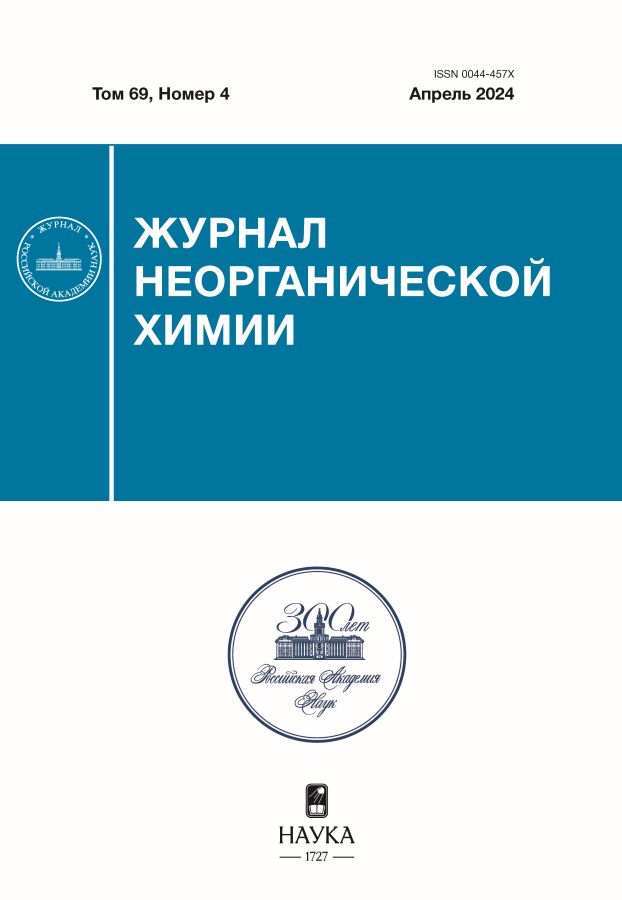Electronic Structure Of Cobalt Phosphates Co1-xmxpo4 Doped With Iron And Nickel Atoms
- Autores: Pecherskaya M.D.1, Galkina O.A.2, Ruzimuradov O.N.3, Mamatkulov S.I.1
-
Afiliações:
- Institute of Materials Science, Uzbekistan Academy of Sciences
- Institute of Chemistry and Physics of Polymers, Uzbekistan Academy of Sciences
- Turin Polytechnic University in Tashkent
- Edição: Volume 69, Nº 4 (2024)
- Páginas: 517-527
- Seção: ТЕОРЕТИЧЕСКАЯ НЕОРГАНИЧЕСКАЯ ХИМИЯ
- URL: https://rjpbr.com/0044-457X/article/view/666566
- DOI: https://doi.org/10.31857/S0044457X24040071
- EDN: https://elibrary.ru/ZYJKHQ
- ID: 666566
Citar
Texto integral
Resumo
In this research, the electronic states, band structures, and bond properties of the framework compounds of CoPO4, Co1-xFexPO4, and Co1–xNixPO4 were investigated by the density functional theory calculations. The potential capabilities of these systems in the photocatalytic water splitting to produce hydrogen were analyzed. The spin-up electron densities of states for the CoPO4, Co1–xFexPO4, and Co1–xNixPO4 systems have band gaps of 2.7, 3.4, and 3.45 eV, respectively. The band of spin-down electron states has several energy gaps above the Fermi level. The density of states of electron with spin up near the Fermi level is obviously greater than that of electrons with spin down. In this case, localized states of electrons appear in the band gap of doped semiconductors due to impurity atoms. The calculated value of the energy at the lower edge of the conduction band for CoPO4 was –0.7 eV, which is more negative than the energy required for water splitting. Meanwhile, the calculated value of the energy at the upper edge of the valence band was 2.01 eV, which is more positive than the oxygen evolution energy of 1.23 eV.
Texto integral
Sobre autores
M. Pecherskaya
Institute of Materials Science, Uzbekistan Academy of Sciences
Autor responsável pela correspondência
Email: mariya.pecherskaya@yahoo.com
Uzbequistão, Tashkent, 100084
O. Galkina
Institute of Chemistry and Physics of Polymers, Uzbekistan Academy of Sciences
Email: mariya.pecherskaya@yahoo.com
Uzbequistão, Tashkent, 100128
O. Ruzimuradov
Turin Polytechnic University in Tashkent
Email: mariya.pecherskaya@yahoo.com
Uzbequistão, Tashkent, 100095
Sh. Mamatkulov
Institute of Materials Science, Uzbekistan Academy of Sciences
Email: mariya.pecherskaya@yahoo.com
Uzbequistão, Tashkent, 100084
Bibliografia
- Raj D., Scaglione F., Fiore G. et al. // Nanomaterials. 2021. V. 11. № 5. P. 1313. https://doi.org/10.3390/nano11051313
- Pecherskaya M.D., Butanov K.T., Ruzimuradov O.N. et al. // Glass Phys.Chem. 2022. V. 48. № 4. P. 327. https://doi.org/10.1134/S1087659622040101
- Saidov K., Shrawan R., Razzokov J. et al. // E3S Web of Conferences. 2023. V. 402. № 14038. https://doi.org/10.1051/e3sconf/202340214038
- Gicha B.B., Tufa L.T., Kang S. et al. // Nanomaterials. 2021. V. 11. № 6. P. 1388. https://doi.org/10.3390/nano11061388
- D’yachkov E.P., D’yachkov P.N. // Russ. J. Inorg. Chem. 2019. V. 64. № 9. P. 1152. https://doi.org/10.1134/S0036023619090080
- Peng X., Pi C., Zhang X. et al. // Sustain. Energy Fuels. 2019. V. 3. № 2. P. 366. https://doi.org/10.1039/c8se00525g
- Liu B., Zhao Y.F., Peng H.Q. et al. // Adv. Mater. 2017. V. 29. № 19. P. 1606521. https://doi.org/10.1002/adma.201606521
- Jiang Y., Lu Y. // Nanoscale. 2020. V. 12. № 17. P. 9327. https://doi.org/10.1039/d0nr01279c
- Sumesh C.K., Peter S.C. // Dalton Trans. 2019. V. 48. № 34. P. 12772. https://doi.org/10.1039/c9dt01581g
- Geng Z., Yang M., Qi X. et al. // J. Chem. Technol. Biotechnol. 2019. V. 94. № 5. P. 1660. https://doi.org/10.1002/jctb.5937
- Rodionov I.A., Zvereva I.A. // Russ. Chem. Rev. 2016. V. 85. № 3. P. 248. https://doi.org/10.1070/rcr4547
- Kim C., Lee S., Kim S.H. et al. // Nanomaterials. 2021. V. 11. № 11. P. 2989. https://doi.org/10.3390/nano11112989
- Samal A., Swain S., Satpati B. et al. // ChemSusChem. 2016. V. 9. № 22. P. 3150. https://doi.org/10.1002/cssc.201601214
- Liu X., Lai H., Li J. et al. // Photochem. Photobiol. Sciences. 2022. V. 21. № 1. P. 49. https://doi.org/10.1007/s43630-021-00139-2
- Lutterman D.A., Surendranath Y., Nocera D.G. // J. Am. Chem. Soc. 2009. V. 131. № 11. P. 3838. https://doi.org/10.1021/ja900023k
- Barroso M., Cowan A.J., Pendlebury S.R. et al. // J. Am. Chem. Soc. 2011. V. 133. № 38. P. 14868. https://doi.org/10.1021/ja205325v
- Ejsmont A., Jankowska A., Goscianska J. // Catalysts. 2022. V. 12. № 2. P. 110. https://doi.org/10.3390/catal12020
- Zhang J., Sun W., Ding X. et al. // Nanomaterials. 2023. V. 13. № 3. P. 526. https://doi.org/10.3390/nano13030526
- Surendranath Y., Kanan M.W., Nocera D.G. // J. Am. Chem. Soc. 2010. V. 132. № 46. P. 16501. https://doi.org/10.1021/ja106102b
- Lutfalla S., Shapovalov V., Bell A.T. // J. Chem. Theory. Comput. 2011. V. 7. № 7. P. 2218. https://doi.org/10.1021/ct200202g
- Giannozzi P., Baroni S., Bonini N. et al. // J. Phys.: Condens. Matter. 2009. V. 21. № 39. P. 5502. https://doi.org/10.1088/0953-8984/21/39/395502
- Ehrenberg H., Bramnik N.N., Senyshyn A. et al. // Solid State Sci. 2009. V. 11. № 1. P. 18. https://doi.org/10.1016/j.solidstatesciences.2008.04.017
- de la Peña O’Shea V.A., Moreira I. de P.R., Roldán A. et al. // J. Chem. Phys. 2010. V. 133. № 2. P. 4701. https://doi.org/10.1063/1.3458691
- Emmeline Yeo P.S., Ng M.F. // J. Mater. Chem. A. 2017. V. 5. № 19. P. 9287. https://doi.org/10.1039/c6ta10674a
- Jain A., Ong S.P., Hautier G. et al. // APL Mater. 2013. V. 1. № 1. P. 011002. https://doi.org/10.1063/1.4812323
- Ludwig J., Nilges T. // J. Power Sources. 2018. V. 382. P. 101. https://doi.org/10.1016/j.jpowsour.2018.02.038
- Gahlawat S., Singh J., Yadav A.K. et al. // Phys. Chem. Chem. Phys. 2019. V. 21. № 36. P. 20463. https://doi.org/10.1039/c9cp04132j
- Gerken J.B., McAlpin J.G., Chen J.Y.C. et al. // J. Am. Chem. Soc. 2011. V. 133. № 36. P. 14431. https://doi.org/10.1021/ja205647m
- Lyons M.E.G., Brandon M.P. // Int. J. Electrochem. Sci. 2008. V. 3. № 12. P. 1386. https://doi.org/10.1016/S1452-3981(23)15533-7
- Artero V., Chavarot-Kerlidou M., Fontecave M. // Angewandte Chemie – International Edition. 2011. V. 50. № 32. P. 7238. https://doi.org/10.1002/anie.201007987
- Delmas C., Cherkaoui F., Nadiri A. et al. // Mater. Res. Bull. 1987. V. 22. № 5. P. 631. https://doi.org/10.1016/0025-5408(87)90112-7
- Zhu Y.P., Ren T.Z., Yuan Z.Y. // Catal. Sci. Technol. 2015. V. 5. № 9. P. 4258. https://doi.org/10.1039/c5cy00107b
- Pearson R.G. // Inorg. Chem. 1988. V. 27. № 4. P. 734. https://doi.org/10.1021/ic00277a030
- Соммер А. Фотоэмиссионные материалы / Пер. с англ. под ред. Мусатова А.Л. М.: Энергия, 1973.
Arquivos suplementares















